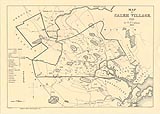
The Salem Witchcraft GIS
A Visual Re-Creation of Salem in 1692
By Mike Furlough, Geospatial and Statistical
Data Center
Primary Researcher: Benjamin Ray, University of Virginia
Aspects of the Project
Related Materials
The GIS of "Salem Village in 1692" is part of an electronic Research Archive of primary source materials related to the Salem witch trials of 1692. The purpose of the GIS is twofold:
First, the GIS gives visual representation of the social context of the witch trials episode by placing the nearly 300 people mentioned in the court records in their actual household locations in the Village. When completed, the database will hold the location of over 150 family households in Salem and surrounding communities. The documents also refer to conflicts between neighbors in the Village and to kinship ties among various families in the Village.
Such relationships are more easily grasped when the locations of the family members and households are displayed on a map. Important property disputes stand in the background of the Village's experience, among families later caught up in the witchcraft trials, and the map shows the disputed property boundries. Since the beginning of historical studies in the 19th century, scholars have used maps has the foundation of their interpretations of the causes of the conflict. This GIS will enable new forms of mapping to further study of the conflicts in Salem.
Second, the GIS is also able to represent in graphic form important demographic information, such as age, gender, frequency of accusations by various individuals, family relationships, relative wealth of accusers and accused -- all of which have played an important role in scholars' interpretations.
Credits
Primary funding for this work is provided by The Electronic Cultural Atlas Initiative.
Further support has been provided by: The Geospatial and Statistical Data Center (Geostat), University of Virginia Library, the Institute for Advanced Technology in the Humanties (IATH), University of Virginia, and the Virginia Center for Digital History (VCDH), University of Virginia.
Primary Researcher: Benjamin Ray
GIS Management: Mike Furlough (Geostat)
GIS Technician: Heather Johnson
Shockwave Animation: Chris Jessee (IATH) & Jeff Evans
(VCDH)
|
© Copyright 1999 The Rector and Visitors of the University of Virginia |